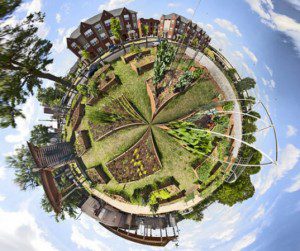Guest writer for Wake Up World
Developed by Australians Bill Mollison and David Holmgren in the 1970’s, permaculture has spread wildly throughout the world. The term initially meant ‘permanent agriculture’, however it evolved to also represent ‘permanent culture’.
Permaculture is the ethical, scientific and synchronistic design of natural systems to ensure a sustainable philosophy of living. It also aims to facilitate abundance for the future of humanity by producing all the food and materials it needs on a local scale. At its core, permaculture is simply the collaboration of humans and nature in action.
Due to the unsustainable agricultural practices that we currently employ, permaculture is also an evidence-based solution to the self-destructive path we are on.
What is Permaculture?
Permaculture is working in conjunction with nature, not against it. It is the local production of all the materials each person needs, such as food, shelter and fuel. Its use of the land is the opposite of a monoculture, which is the hallmark of the harmful industrial-agriculture model. Instead it’s a polyculture, where a diverse range of vegetation and animals are utilised to support each other into abundance.
[pro_ad_display_adzone id=”110028″]
As a quick overview, a permaculture plot has five zones. The first is the most utilised and is therefore the closest to the residence, which contains vegetable and herb gardens that need continual maintenance. Zone two is where daily attention is still required, but not as often, such as with poultry pens and orchard trees. The third zone is less visited and generally reserved for self-feeding stock and seasonal crops. In zone four there are food and fuel options made available from the food forest and zone five is a natural area that is rarely visited.
“The aim is to create systems that are ecologically-sound and economically viable, which provide for their own needs, do not exploit or pollute, and are therefore sustainable in the long term” – Bill Mollison
 Once a permaculture farm is fully functioning, in principle nothing needs to be brought into the system as it supplies all of its own requirements. Food for humans, animals, soil and plants are produced by the plants and animals themselves. The sunlight and water that enters the property is captured in a way which maximises its potential, which is also obviously used for the plot’s energy requirements.
Once a permaculture farm is fully functioning, in principle nothing needs to be brought into the system as it supplies all of its own requirements. Food for humans, animals, soil and plants are produced by the plants and animals themselves. The sunlight and water that enters the property is captured in a way which maximises its potential, which is also obviously used for the plot’s energy requirements.
It has three core tenets, which is to care for the earth, care for the people and return of surplus. These tenets are self-explanatory. It also has twelve design principles, which I won’t go into here, but which provide a guiding template for developing each unique permaculture system.
“Permaculture is a design science. It’s a system that supplies all the needs of humanity – all the basic needs and all the intricate needs – in a way that also benefits the environment” – Geoff Lawton
Each area has layers, such as the canopy, understory, groundcover and vertical growing plants. The layers incorporate seasonal, annual and perennial plants too. Everything has multiple uses, such as chickens which provide food, prepare the soil and supply manure. Another example is that a specific plant is not just a food, but provides a particular role for the soil and other plants, as well as delivers organic material for the worm farm and to make compost.
Vegetation is planted in guilds, which is essentially a grouping of mutually beneficial plants. They can also include animals too. For example, a guild might contain a nitrogen-fixing legume for the soil, vegetation that attracts pollinator insects and repels harmful ones, shrubs that are great for chop-and-drop mulch and plants which are principally for food or aesthetic purposes.
When setting up a permaculture plot, it is important to adapt to local conditions. For example, living in an urban environment has its limitations, such as space, however it can be overcome by clever design. Different climates, particularly harsh ones, also provide a challenge; however highly successful projects have illustrated that the permaculture methodology can be achieved anywhere, including in desert, mountainous and snowy environments.
Why Is It Important?
“Though the problems of the world are increasingly complex, the solutions remain embarrassingly simple” – Bill Mollison
The statistics of consumption rates are frightening. The projected outcomes of overconsumption and the abuse of our earth are dire, especially as we are already consuming 50% more resources than the planet can sustain. Permaculture aims to address these and other issues by developing models which ensure that humanity can not just survive, but thrive, even in an ‘oil obsolete world’.
 Permaculture plots can be designed in small or large scale settings. They can very easily solve some of the mess that humanity has created for itself, such as the shortage of healthy and clean food and water, as well as the destructive imbalance our species has created on our Mother Earth and its interconnected and interdependent species.
Permaculture plots can be designed in small or large scale settings. They can very easily solve some of the mess that humanity has created for itself, such as the shortage of healthy and clean food and water, as well as the destructive imbalance our species has created on our Mother Earth and its interconnected and interdependent species.
One example, among many, is the devastating impacts of industrial agriculture. It may have sped up the cultural evolution of humanity, but on a large and widespread scale it damages the natural world, including animal colonies such as bees, and has created a decline in the nutrient levels of the food it produces. It relies on fossil fuels, such as the oil required for machinery, fertilisers and pesticides. It kills the soil of its life, which includes bacteria, fungi, protozoa, nematodes, arthropods and earthworms. It essentially kills natural systems.
Industrial agriculture also requires high input for the associated output. Another important point is that it doesn’t even feed the local population; through free trade agreements food is unnecessarily shipped all over the globe and immorally misses the people who need it most, whilst so much waste is created in the so-called ‘developed’ nations. Industrialised farming simply has to go, for the death of it will be the conscious birth of humanity’s sustainable partnership with planet earth.
“Consciously designed landscapes which mimic the patterns and relationships found in nature, while yielding an abundance of food, fibre and energy for provision of local needs” ~ David Holmgren
Final Thoughts
A growing proportion of the population are awakening to the challenges that face our global culture. Many are preparing themselves for the fallout of an increasingly interdependent global economy that is plagued with bubbles waiting to inevitably burst. All this can appear as overwhelming and that we are powerless to do anything about it. But we can. Permaculture plots can be created for ourselves, our family and our community no matter where we live; all we have to do is get our hands dirty – in our own backyards.
“You can solve all the world’s problems in a garden” ~ Geoff Lawton
Previous articles by Phillip J. Watt:
- The Ego is the Source of Suffering AND Contentment
- The Orchestra of Reality – a Journey through Science, Spirituality & Symbolism
- 8 Emotional Patterns That Can Disturb Our Inner Peace
- 8 More Emotional Patterns That Can Disturb Our Inner Peace
- Finding Our Peace: The Art of Loving Our Experience
- A Day in the Life of Mindfulness
- The New Age of a United Global Culture
- A Guide to Unity: Transcending the Illusion of Disconnection
- Permaculture – What Is It and Why Is It Important?
- Matter vs. Spirit – A Guide to Participating in the Greatest Debate Ever
About the author:
 Phillip J. Watt lives in Sydney, Australia. He identifies as a ‘self-help guide’ as he has long focused on his physical, mental, emotional and spiritual health and then shares those lessons with his clients and readers. His written work also deals with topics from ideology to society, as well as self-development.
Phillip J. Watt lives in Sydney, Australia. He identifies as a ‘self-help guide’ as he has long focused on his physical, mental, emotional and spiritual health and then shares those lessons with his clients and readers. His written work also deals with topics from ideology to society, as well as self-development.
Phil has a degree in Social Science and Philosophy and has been trained extensively in health services. He assists adults, children and families as a mentor, relationship mediator and health and life teacher. He also provides online support services for personal healing and growth, assisting his clients to grow their skills and knowledge in life management and adventure.
Follow him on Facebook or visit his website www.vitalityguidance.com where you can reach him for a personal appointment.
[pro_ad_display_adzone id=”110027″]







